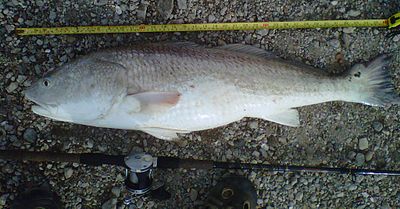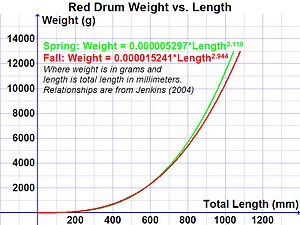- Red drum
-
Red Drum 
Red Drum - Texas City TX May 2, 2011 Scientific classification Kingdom: Animalia Phylum: Chordata Class: Actinopterygii Order: Perciformes Family: Sciaenidae Genus: Sciaenops
Gill, 1863Species: S. ocellatus Binomial name Sciaenops ocellatus
(Linnaeus, 1766)The Red Drum (Sciaenops ocellatus), also known as Channel Bass, Redfish, Spottail Bass or simply Reds, is a game fish that is found in the Atlantic Ocean from Massachusetts to Florida and in the Gulf of Mexico from Florida to Northern Mexico.[1] It is the only species in the genus Sciaenops. The red drum is a cousin to the Black Drum (Pogonias cromis), and the two species are often found in close proximity to each other, they can interbreed and form a robust hybrid, and younger fish are often indistinguishable in flavor.[2]
Contents
Characteristics
Red Drum are a dark red color on the back, which fades into white on the belly. The red drum have a characteristic eyespot near the tail and are somewhat streamlined. Three year-old red drum typically weigh six to eight pounds. When they are near or over twenty-seven inches, they are called “bull reds”. The largest red drum on record weighed just over 94 pounds and was caught in 1984 on Hatteras Island. Red drum are relatives of the black drum and both make a croaking or drumming sound when distressed.
The most distinguishing mark on the red drum is one large black spot on the upper part of the tail base. Having multiple spots is not uncommon for this fish but having no spots is extremely rare. As the fish with multiple spots grow older they seem to lose their excess spots. Scientists believe that the black spot near their tail helps fool predators into attacking the red drum's tail instead of their head, allowing the red drum to escape.[3] The red drum uses its senses of sight and touch and its down turned mouth, to locate forage on the bottom through vacuuming or biting the bottom. On the top and middle of the water column, it uses changes in the light that might look like food. In the summer and fall, adult red drum feed on crabs, shrimp, and sand dollars, in the spring and winter, adults primarily feed on menhaden, mullet, pinfish, sea robin, lizardfish, spot, Atlantic croaker, and flounder.
Distribution
Red drum naturally occur along the southern Atlantic and Gulf of Mexico coasts of the United States, including the coasts of Louisiana, Alabama, Mississippi, and Florida. Aquaculture activities involving Red Drum occur around the world.[4] Immature red drum prefer grass marsh areas of bays and estuaries when available. Both younger mature red drum (3-6 years of age) and bull red drum prefer rocky outcroppings including jetties and manmade structures, such as oil rigs and bridge posts. Around this type of structure, they are found throughout the water column.
Reproduction and Growth
Mature red drum spawn in near shorelines from mid-August to mid-October.[5] The Red Drum's eggs incubate for 24 hours. A female lays about 1.5 million (with a range of 200,000 up to more than three million) eggs per batch. Scharf (2000) reported that in the first year, young red drum in Texas estuaries grew about 0.6 mm per day, though the rates varied with location and year and were higher in more southerly estuaries.[6] After the first year they may be 271 – 383 mm long. About half of red drum are able to reproduce by age 4 years, when they are 660-700 mm long and 3.4 – 4 kg in weight. Red drum live to be 60 years old unless caught.
As red drum grow longer, they increase in weight. The relationship between length and weight is not linear. The relationship between length (L) and weight (W) for nearly all species of fish can be expressed by an equation of the form:
Invariably, b is close to 3.0 for all species, and a varies between species. Jenkins (2004)[7] reported slightly different weight-length relationships for red drum caught in the spring and the fall off the western Gulf Coast of Louisiana:
where weight is in grams and length is total length measured in millimeters. For example, these relationships predict that a 600 mm red drum (just under two feet long) would weigh about 2300 grams (just over five pounds). These relationships can be used more specifically to determine how healthy a sample of red drum are by comparing their actual weights to weights predicted by these relationships for the same length.
Consumption
Redfish was named as giving a good result with court-bouillon in a cookbook published in New Orleans in 1901.[8]
In the early 1980s, the chef Paul Prudhomme made his dish of Cajun-style blackened redfish (red drum) popular. When catches of redfish declined in the 1980s many believed that it was being commercially over-fished because of its recent popularity. However, redfish numbers started declining in the late 1970s, possibly because of over-fishing of young redfish in shallow coastal waters by recreational fishermen.
On March 1, 2009 redfish was the "secret ingredient" on the television program Iron Chef America, with competitors Mourad Lahlou and Cat Cora both preparing several dishes from the fish.
Red drum have a moderate flavor and are not oily. Big drum can be challenging to clean; removing the large scales can be challenging. Many fishers prefer to fillet with an electric knife, first removing the fillet from along the backbone, and then using the electric knife to cut the fillet from the skin and scales. Fish over 15 lbs can become tough and have a consistency comparable with chicken, rather than the flakey texture of many species of fish. Younger fish are often indistinguishable in flavor from black drum.[9]
Commercial and Recreational Use
Red drum are often found over sand and sandy mud bottoms in coastal waters and estuaries. They feed mainly on crustaceans, mollusks and fishes. They will readily accept any bait, but adults prefer menhaden (a small bait fish), shrimp, mud minnows and crabs.[10] Since they are bottom feeders, they are commonly caught with bait either on the bottom or suspended within a couple feet of the bottom. Shrimp is a typical bait that works well; squid can also be used and is less subject to bait stealing by hardhead catfish and Atlantic croakers which often frequent the same waters. There are times when the older, larger fish are more readily caught on a half or a quarter of a blue crab with the top shell removed and cut or broken to fit on a 4/0 to 9/0 hook. Baitfish such as pinfish can also be effective, along with a variety of other techniques.
Large, adult red drum grab the bait with a high amount of speed, keep going with a good amount of speed, and can put up a fight. An unsecured rod may easily be pulled into the water. Landing these big fish on light tackle can be challenging, and since drum are primarily scent-based feeders, there is little disadvantage in using heavier line and tackle, especially in stained or deeper water. A 40-lb braided line with a comparable weight fluorocarbon leader is a good compromise between castability and strength. However, big drum are frequently caught with everything from 8-lb monofilament to 100-lb braided lines with heavy steel leaders. The bigger red drum of the Atlantic surf usually like to mouth their food a little, and some fishermen prefer to wait 5 or 6 seconds before reeling in because they want the fish to fully swallow the bait.[11]
An effective strategy for fishing from a boat is to select a spot with a sandy bottom or oyster bed where food is plentiful at a time of day with some tidal movement. Pier or bank fishing should target jetties, structure, or a boat channel near a rapid increase in depth and some tidal movement. Because bigger drum can make a long, strong run right after taking the bait, preventing broken line often requires a relatively light drag setting early in the fight.
From 1980 through 1988, commercial fishermen took an average of 28% of the redfish while sport fishermen harvested 72 percent. Catch limits and size restrictions have increased the average weight of redfish caught in Louisiana coastal waters.[12] Restrictions on both sport and commercial fishermen allowed the species to rebuild. States actively vary the recreational catch limits and minimum and maximum lengths in order to help maintain sustainable red drum populations. Executive Order 13449 of October 20, 2007, issued by former U.S. President George W. Bush, designated the Red Drum as a protected game fish. The Order prohibits sale of Red Drum caught in Federal waters and encourages states to consider designating Red Drum as a protected game fish within state waters.[13] While they may no longer be commercially harvested in U.S. federal waters or in most state waters, they are readily caught and still enjoyed as table fare by many. In addition, farm raised redfish are still available as a commercial product [14]
Relationship to humans
The North Carolina General Assembly of 1971 designated the Red Drum as the official State Salt Water Fish. (Session Laws, 1971, c. 274; G.S. 145-6).[15]
Notes
- ^ Sciaenops ocellatus, Froese, R. and D. Pauly. Editors. 2009.FishBase. World Wide Web electronic publication. www.fishbase.org, version (07/2009). http://www.fishbase.org/Summary/SpeciesSummary.php?id=425
- ^ A Comparison of Black Drum, Red Drum, and their Hybrid in Saltwater Pond Culture Anne Henderson-Arzapalo, Robert L. Colura, Anthony F. Maciorowski, Journal of the World Aquaculture Society Volume 25 Issue 2, Pages 289 - 296
- ^ Smithsonian Marine Station page on Red Drum
- ^ Peters Life History of Red Drum Peters, K.M., McMichael Jr., R. H. Florida Department of Natural Resources Bureau of Marine Research, St. Petersburg, Florida.
- ^ Wilson and Nieland, 1994
- ^ Scharf 2000
- ^ Jenkins, J.A. Fish bioindicators of ecosystem condition at the Calcasieu Estuary, Louisiana. National Wetlands Research Center, USGS, Open-File Report 2004-1323, 2004
- ^ Anonymous. (1901). "The Original Picayune Creole Cook Book." New Orleans: Times-Picayune Publishing Corporation. (reprinted 1906, 1916, 1922, 1928, 1936, 1938, 1942, 1945, 1947, 1954, 1966, 1971.)
- ^ A Comparison of Black Drum, Red Drum, and their Hybrid in Saltwater Pond Culture Anne Henderson-Arzapalo, Robert L. Colura, Anthony F. Maciorowski, Journal of the World Aquaculture Society Volume 25 Issue 2, Pages 289 - 296
- ^ Sciaenops ocellatus, Froese, R. and D. Pauly. Editors. 2009.FishBase. World Wide Web electronic publication. www.fishbase.org, version (07/2009). http://www.fishbase.org/Summary/SpeciesSummary.php?id=425
- ^ Ken Schultz’s Essentials of fishing. The Only Guide You Need to Catch Freshwater and Saltwater Fish. Schultz, Ken. John Wiley & Sons Inc.
- ^ Understanding Redfish Biology - accessed August 6, 2009
- ^ "Executive Order 13449: Protection of Striped Bass and Red Drum Fish Populations". Office of the Federal Register. October 20, 2007. http://www.archives.gov/federal-register/executive-orders/2007.html#13449. Retrieved October 24, 2007.
- ^ Fritcheey, Robert (1994). Wetland Riders. Golden Meadow, Louisiana: New Moon Press.
- ^ Official State Symbols of North Carolina
References
- "Sciaenops ocellatus". Integrated Taxonomic Information System. http://www.itis.gov/servlet/SingleRpt/SingleRpt?search_topic=TSN&search_value=169290. Retrieved 24 January 2006.
- Texas Parks and Wildlife Department. Red Drum (Sciaenops ocellatus). Retrieved on 6 August 2009.
- Froese, Rainer, and Daniel Pauly, eds. (2005). "Sciaenops ocellatus" in FishBase. November 2005 version.
Categories:- Sciaenidae
- Fly fishing target species
- Edible fish
- Commercial fish
- Sport fish
- Seafood
- Fish of the Atlantic Ocean
- Animals described in 1766
Wikimedia Foundation. 2010.





